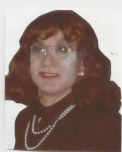André Joyce Fan Club | GAMES | Chi Xi Digamma | Googology | Hierogonometry | Jootsy Calculus | links | Merology | neologisms | Oogology | Pataphysics | Sequences
 Welcome to the Andre Joyce Fan Club site
Welcome to the Andre Joyce Fan Club site hosted for you by Razilee Purdue. I hope you'll enjoy your visit. For those of you not familiar with the work of Andre Joyce -- and who is!! -- he was the Franco-American mathematician-cum-creative-writer who coined such words as "oogol" and "dibious".
He considered himself a pataphysicist -- a theorist -- rather than the more practical-sounding derivative, pataphysician. Pataphysics means "beyond metaphysics", the Anglocized form of the French 'Pataphysique, a pun on "patte …physique", and the Greek (e)p(i met)a ta physika, the science of imaginary solutions that studies the exceptions rather than laws and aspires to provide imaginary solutions to practical problems. It was first mentioned in Ubu roi (1896) by Alfred Jarry and later in the "neoscientific romance" Geste et opinions du docteur Faustroll, 'Pataphysicien (1911) by Alfred Jarry (translated in 1965 as "Exploits and Opinions of Dr. Faustroll, 'Pataphysician" in Selected Works of Alfred Jarry ed. by Roger Shattuck and SimonWatson-Taylor, including "The Crucifixion of Christ Considered as anUphill Bicycle Race" and "Commentair pour servir … la construction pratique de la machine … explorer le temps", translated as "How to Construct A Time Machine". This in turn inspired "The Assassination of John Fitzgerald Kennedy Considered as a Downhill Motor Race" (1967) by J.G. Ballard.
Whether one practices it as pataphysicist or pataphysician, it's a systematic toying with the arrangement of things and their significance until the improbable hypothesis can be seen as real, the examination of the laws governing exceptions to better explain or describe the universe. It does this obscurely with puns, wordplay, allusions, hierogamies, with co-existing and contrasting impulses shifting frequently but without sinister overtones, but with comic-seriousness. It "rests on the truth of contradictions and exceptions" (Shattuck), on the Law of the Equivalence of Opposites, (KCpNpCNpp.)* Opposites neither cancel each other out nor exist statistically as contraries. Nor are their differences resolved in a dialectical analysis.
Rather, they shuttle back, forth, and around in an open-ended spiral. (gidouille).
Alfred Jarry (1873-1907) also helped found the theatre of the absurd. Pataphysics is continued by the College de 'Pataphysique, founded 1948, and the Oulipoeans of the Oulipo (L'Ouvroir de Litterature Potentialle) founded in 1960 by Raymond Queneau and Francois Le Lionnais, inspired by linguistic theories of Ferdinand de Saussurre, that art is produced by the friction generated by an author's imagination working against formal constraints, including Harry Matthews, George Perec and Pamela Zoline's "The Heat Death of the Universe" (1967). t zero (Qfwfq, 1969), related to magic realism of Jorge Luis Borge, Donald Barthelme, John T. Sladek's The Mueller-Fokker Effect (1970), Fireworks (1974) and Angela Carter's Nights at the Circus (1984) about winged woman, metafictionist Italo Calvino (The Castle of Crossed Destinies, 1977, plotted using Tarot cards, "living" suit of armor.
The College's statutes are:
Article One: The Statuetes of the College of 'Pataphysics are pataphysical
Article Two: "Pataphysics is the science..."
Article Three: Since the human race is composed entirely of pataphysicians, the College of 'Pataphsics distinguishes between those who are conscious of the fact and those who are unconscious. The College of 'Pataphysics promotes 'Pataphysics in this world and in all others.
Some such science fiction would be: Don DeLillo's Ratner's Star (1976), Rudy Rucker's White Light, orWhat is Cantor's Continuum Problem? (1980), The Names (1982), Thomas Disch's 334, Vladimir Nabokov, The 57th Franz Kafka (1983), Tik-Tok (1983) (alphabent chapters), The Sex Sphere (1983), The Lunatics of Terra (1984),Master of Space and Time (1984), The Secret of Life (1985), Transreal! (1991).
*[NOTE: Joyce used Lukosiewicz (aka Polish) notation for logical operators, a modified Ackerman Generalized Exponential notation for higher mathematical ones and 00 (double zero) for Aleph-null infinity. Thus Axy = disjunction (x OR y), Cxy = implication (x THEREFORE y), G(0, x, y) = addition (x plus y), G(1, x, y) = multiplication (x times y), G(2, x, y) = exponentiation (y-to-the-xth), G(3, x, y) = tetration (to-the-xth-y), G(x, y, z) = G(x - 1, y, G(x, y - 1, z)) = G(1, x, y, z), G(2, x, y, z) = G(x, G(x, y, z), z) = G(1, 2, x, y, z), etc. Kxy = conjunction (x AND y), Nx = negation (NOT x),. Other operators used are: div(i) = divisors of i, dr(x) = digital root of x, p(x) = xth prime, R(x) = digital reversal of x, x! = x factorial = G(x - 1, 1, 1, i), x# = x primorial, and [x] = the integral portion of x. We will simplify his more complex expressions: d(x(i)) = ith digit of x = [x/G(2, i, 10) - x/G(2, i + 1, 10)], P(f(x)) = product of f(i) from i = 1 to i = x; G(x - 1, 1, f(1), f(i)), S(x) = numerical sort of digits = G(x, 1, [x/G(2, i, 10) - x/G(2, i + 1, 10)]) > G(x, 1, [x/G(2, i + 1, 10) - x/G(2, i + 2, 10)]), #(x) = numerical count of x